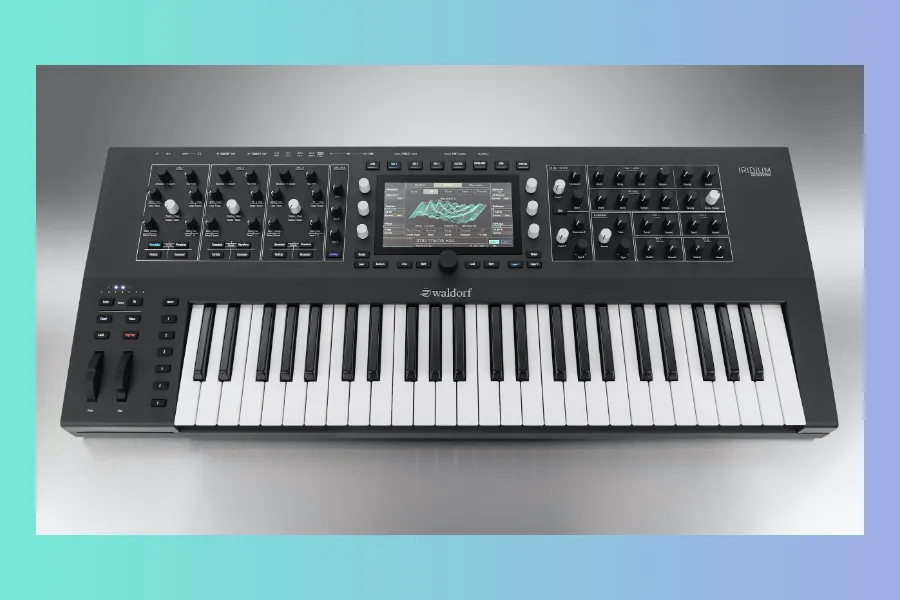5. March 2022 | News | Carl
Waldorf Music releases Iridium Keyboard

Waldorf Music is proud to take the concept further forward by announcing availability of its Iridium Keyboard counterpart — radically redesigning its desktop synthesizer namesake around an all-new 49-key FATAR TP/8SK semi-weighted polyphonic aftertouch pressure-providing keyboard as the first such implementation of that keyboard in the world, with an expanded front panel proffering one-knob-per-function control as a workflow-raising result of this high-class synthesizer’s palpable physical makeover, also allowing for six freely-programmable Macro buttons with which users can define functions from a wide range of features for additional performance control.
It is, however, hardly surprising that Waldorf Music has chosen to name its latest high-quality synthesizer Iridium Keyboard since the instrument in question is physically designed around award-winning Italian digital piano, organ, and synthesizer keybed manufacturer FATAR’s all-new TP/8SK keyboard, configuring 49 semi-weighted sensitive keys with polyphonic aftertouch and three contacts as possibly one of the best synthesizer keyboards money can buy. Best of all, tremendous tonal changes flow freely when playing the Iridium Keyboard live since polyphonic aftertouch is transmitted individually for each note played. Performers can conceivably play and hold down any number of keys simultaneously, subsequently moving each finger individually. In other words, individual keys are affected by the pressure applied by each finger, thereby creating, for instance, individual data streams for modulation purposes, whereas with monophonic (Channel) aftertouch all notes played will respond in the same way. With a powerful Mod Matrix offering 40 independent modulation assignments, each with individual settings for Source, Amount, and Destination, Iridium Keyboard far from disappoints when it comes to powerful modulation options, of course — just like its Iridium desktop synthesizer namesake. Notably, Iridium Keyboard is also capable of processing MPE (MIDI Polyphonic Expression) data, duly making multiple parameters of different notes separately controllable to effectively enable it to behave more like an acoustic instrument in terms of spontaneous, polyphonic sound control.
Clearly, the 851 mm (W) x 355 mm (D) x 110 mm (H) physical dimensions of Iridium Keyboard has resulted in some marked differences to the original Iridium desktop design, with a one-knob-per-function control approach afforded by its naturally expanded front panel, albeit aided still by its industrial-grade highly-responsive touchscreen display to provide an interactive overview of the Mode page selected (via associated LFOS, OSC 1, OSC 2, OSC 3, FILTERS, MOD, and EFFECTS buttons), parameter changes, and additional information. Indeed, Iridium Keyboard also incorporates six freely-programmable Macro buttons adjacent to the Pitch and Mod (modulation) wheels with which users can define functions from a wide range of features for additional performance control, combining to further enhance its performance pedigree.
Put it this way: while Iridium Keyboard — duly described by Waldorf Music as “…a high-class synthesizer with an extraordinary polyphonic aftertouch pressure keyboard featuring a wide range of unique sounds with approved Waldorf quality — made in Germany!” — ships with specifically created new sounds and samples in addition to all those included in the Iridium desktop from the likes of Kurt Ader, BT (Brian Transeau), Richard Devine, Thorsten Quaeschning (Tangerine Dream), and Howard Scarr, to name but a notable few, its impressive specification otherwise mirrors that of the original Iridium — itself described by Waldorf Music as “…a high- class desktop synthesizer featuring a wide range of unique sounds with approved Waldorf quality — made in Germany!” — as a 16-voice digital synthesizer. Sounds from Waldorf Music’s Quantum synthesizer flagship — an eight-voice, hybrid affair as a result of offering two analogue low-pass filters per voice — can conveniently be loaded into Iridium Keyboard and vice-versa.
As another entry fit for Waldorf Music’s rich history, Iridium Keyboard — with its industrial design bearing the high-class hallmarks of Axel Hartmann, one of the most respected synthesizer designers in the industry who was also responsible for the company’s wavetable synthesis-based Microwave debut back in 1989 — takes pride of place in the high-quality German synthesizer developer’s distinctive family tree as another direct descendent of the legendary PPG Wave synthesizer series that made their mark throughout the Eighties by bringing the distinctive sound of wavetable synthesis to the musical masses. Musically, though, the Iridium Keyboard — like its Iridium desktop synthesizer sibling — brings much more to the production table than its acclaimed ancestor, featuring five different synthesis models for each of its three oscillators (OSC 1, OSC 2, and OSC 3): Wavetable — a table consisting of single-cycle waveforms; Waveform (virtual analogue) — a standard oscillator model to create typical analogue waveforms; Particle (sampling and granular sampling) — allowing for extensive manipulation of sample-based sounds; Resonator — manipulates multi- samples from the internal (2GB) sample flash memory or noise via an exciter and various spectral parameters that can be modulated, matchless for generating awe- inspiring animated sounds and drones, which can, for example, easily be integrated into a Eurorack modular synthesizer environment via the Iridium Keyboard’s integrated control voltage connections (CV In1, CV In2, CV In3, and CV In4); and Kernels — effectively enabling one oscillator to become up to six sub-oscillators that can be interlinked through FM at audio rate and arranged in user-definable constellations. Clearly, Iridium Keyboard can create a wide range of unique sounds like no other.
Other fanciful features include three true stereo path digital filters per voice that convincingly cover all conceivable classic filter variants — various digital filters are additionally offered by the FORMER section, such as Comb, classic Waldorf high- and band-pass, and notch filters from Waldorf Music’s Largo and Nave software synthesizers, plus PPG models, alongside signal enhancer effects, such as Drive and Bit Crusher, and more; six envelopes, six LFOs, and much more besides are available for use as sources in the Mod Matrix, routable to almost any numerical value in Iridium Keyboard.
Connectivity-wise, the well-spec’d Iridium Keyboard communicates well with the outside world, thanks to two audio inputs (for processing external signals); CV inputs as well as Gate In and Trigger In connections (for forwarding external signals to the Mod Matrix); Clock In and Clock Out connections (to synchronise with other gear); USB and DIN MIDI connections; USB Host port (provided for MIDI devices and also handling data exchange); Control and Sustain Pedals inputs; a headphone output (with dedicated volume control); and last, but not least, two audio outputs.
On the face of it, then, with a performance pedigree fit for taking its wide-ranging unique sounds further forward, the reassuringly-weighty (12.0 kg) Iridium Keyboard certainly more than lives up to its billing as “…a high-class synthesizer with an extraordinary polyphonic aftertouch pressure keyboard featuring a wide range of unique sounds with approved Waldorf quality — made in Germany!”
Iridium Keyboard is available through Waldorf Music’s growing global network of distributors (https://www.waldorfmusic.com/en/international-distributors) at an RRP (Recommended Retail Price) of €2,989.00 EUR (including German tax).
For more in-depth information, please visit the dedicated Iridium Keyboard webpage here: Waldorf – Iridium keyboard
Hear Iridium Keyboard in action while watching Waldorf Music’s must-see trailer and sound demonstration video here:




